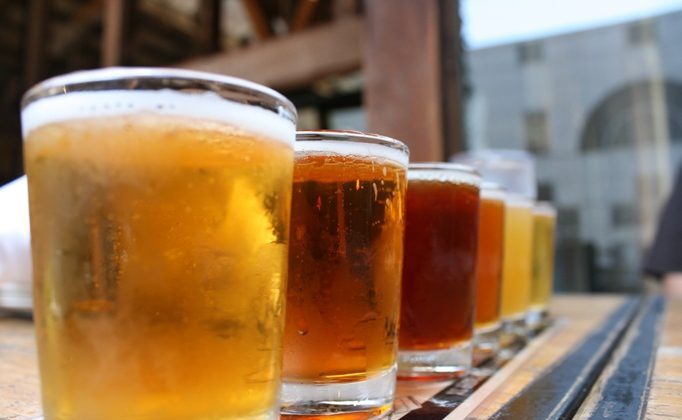Craft beer in Japan is experiencing the start of its second boom, riding on renewed consumer interest, passionate local microbreweries, and rising import costs. All of these are making domestic craft beers more affordable for consumers.
I have been an avid craft beer fan since 2010, when I had my first bottle of Wittekerke Rose in a Belgian restaurant. Intrigued by the recent surge in craft beer popularity, I visited various breweries and brewpubs in Japan to discover the driving forces behind this phenomenon.
Next Article
Japan’s Unexpected Gateway to Europe
From McDonald’s to Mercari (Part 1 of 3)
A Brief History of Craft Beer in Japan
Japan’s beer culture can be traced back to 17th century Edo Period when the Dutch opened a beer hall for sailors traveling between Japan and the Dutch Empire. In 1853, Koumin Kawamoto, a medical doctor, brewed one of the first beers in Japan, following instructions from a Dutch book. By the Meiji Period, the Japanese beer industry started to flourish with the arrival of overseas brewers, as well as the establishment of breweries such as Spring Valley Brewery in 1870 and Hokkaido Kaitakushi Beer Brewery in 1876.
The Beer Tax Law enacted in 1901 led to minimum production volumes of 1,800 kiloliters for brewing licenses. This law greatly restricted the growth of small-scale operations and contributed to the domination of major breweries such as Kirin Brewery Company and Osaka Beer Company (now known as Asahi Breweries). The demand for beer increased rapidly during the economic recovery of the 1950s, such that minimum production volumes for brewing licenses was raised to 2,000 kiloliters in 1959, further solidifying the position of major players in Japan.
From there, the Japanese beer industry remained relatively stagnant until 1983, when licensed production of foreign brand beers began. Four years later, in 1987, the major breweries engaged in the Dry Wars and began development of happoshu (low malt beer) and cheap malt-free “third beer.” At last, the minimum production volumes for brewing licenses was lowered to just sixty kiloliters for beer and six liters for happoshu, rejuvenating the industry and heralding the start of the first microbrew boom in Japan, where hundreds of brewpubs and microbreweries sprung up to take advantage of deregulation.
Unfortunately, the first microbrew boom was short lived. The industry peaked at 310 microbreweries in 1999, none of which were able to produce “mini-industrial” beers of a quality that appealed to domestic consumers. By 2007, only about 280 microbreweries had survived.
Despite the grim initial outlook, craft brewers managed to beat market expectations. The stagnant beer industry started off 2016 expecting to register -0.8% compound annual growth rate (CAGR), while the craft beer market expected growth rates of 0.5% to 1.0%, with more than 40% of craft beer production sold online.
How are brewers in the Japanese craft beer industry able to survive and thrive in a niche segment of a stagnant industry? It all boils down to passion within the community.
Key Factors of the Japanese Craft Beer Industry
The craft beer market is well supported by a passionate community of fans who formed the non-profit Japan Craft Beer Association (JCBA) in 1994. The association is responsible for organizing two of the biggest beer competitions in Japan: the International Beer Competition (started in 1996) and the Japan & Asia Beer Cup (ongoing since 1998).
There are two key drivers behind this growing craft beer trend:
- The accessibility of information and products via the internet
- The changing palate of the Japanese people
The majority of craft beer consumers are under forty and enjoy craft beer as a social trend or tasty complement to increasingly complex food styles.
More importantly, the industry is attracting international craft brewers who are passionate and committed to long-term sustainability.
One great example is the talented brew master, Scott Brimmer, from Brimmer Brewing in Kanagawa. Established relatively recently (2011), the brewery has already won numerous awards, including the bronze for both Porter and Golden Ale at the International Beer Competition in 2012.
The absence of market pressure from major breweries in Japan is going a long way to helping microbreweries in the Japanese craft beer industry space to grow. And the existence of passionate craft beer fans and brew masters helps to create a great platform to fuel the growth of the industry.
How? The answer is three-fold.
A Mutual Network
As the craft beer community grows, brewers and companies will grow accordingly to supply demand. Recently, Blue Moon Brewing from the USA has announced plans to increase its efforts cultivating the Japanese market by educating consumers about Belgian craft beers.
An External Network
As the craft beer community grows, the market will attract more fans, brew masters, and companies. A classic example of this domino effect is Kiuchi Brewery, a traditional sake brewery that saw opportunities for craft beer and, in 1996, launched a brand to great success called Hitachino Nest Beer. The brewery remains one of the largest Japanese exporters of craft beer, with over 60% of sales coming from overseas markets.
Retention
As the community continues its shared passion for craft beer, customers, brew masters, and companies further adhere to the craft beer platform, thus increasing the industry’s retention rate.
Challenges for the Japanese Craft Beer Industry
While the Japanese craft beer industry is currently booming, it remains only a small fraction of the total beer market, estimated to be worth around US $29 billion. The current state of Japanese craft beer is similar to the early days of the US industry, during which the majority of microbreweries experienced capacity and distribution issues.
It does seem, however, that craft brewers in Japan have learned from the first microbrew boom and are proceeding with caution. Most are slowly building organizational capabilities, production capacities, and ties to domestic suppliers and consumers. They seem willing to sacrifice short-term profits from overseas markets in favor of long-term demands of domestic customers. The majority will attempt to venture overseas only once they are able to meet both the domestic and global demand.
Another key element of market growth is consumer education—something that craft beer players are slowly investing in. For the first anniversary of Brimmer Brewery in March 2013, the brewery held a craft beer and buffet dinner at the Hilton Tokyo to showcase food pairings for their award-winning Porter and Golden Ale. At the Japan launch party for Blue Moon Brewing in June 2013, staff instructed guests on the pouring and serving of Blue Moon, as well as food pairings for the beer.
Community education is proving to be a major asset for the Japanese craft beer industry.
Parallels with the Japanese Sake Industry
Interestingly, key issues in the modern Japanese craft beer industry mirror the sake industry, which can be traced back to the Nara Period (710 – 794 AD). Today, sake breweries can be generally divided into traditional breweries and regional jizake breweries (equivalent of craft beer breweries). Both are seeing a decline, as consumption of Japanese sake is now only a third of what it was at its peak in 1975. Back then, 1.7 million kiloliters of sake was produced across the country.
The decline can be attributed to the aging population. After all, sake consumers are typically over fifty-five years old, and the traditional brand image of sake does not appeal to the younger generation.
Despite a gloomy domestic outlook, there is a silver lining in an increase of overseas demand. Exports reached 14 million liters in 2011 due to the growing popularity of Japanese food styles in overseas markets. Similar to the craft beer industry, sake faces the issues with distribution and consumer education. Entities such as the Japan Prestige Sake Association and the Sake Service Institute have emerged to combat this.
With any luck, these efforts will continue to reap dividends for both sake and craft beer, promoting the industries so many of us have grown to love.





